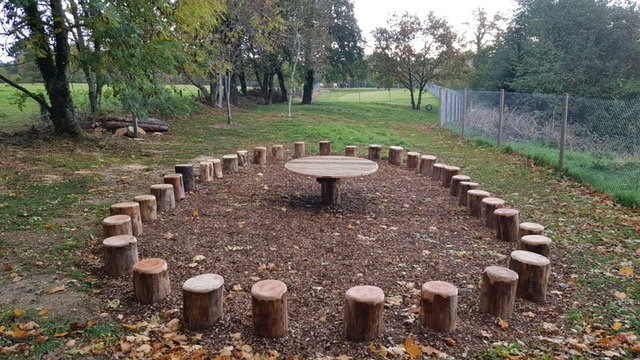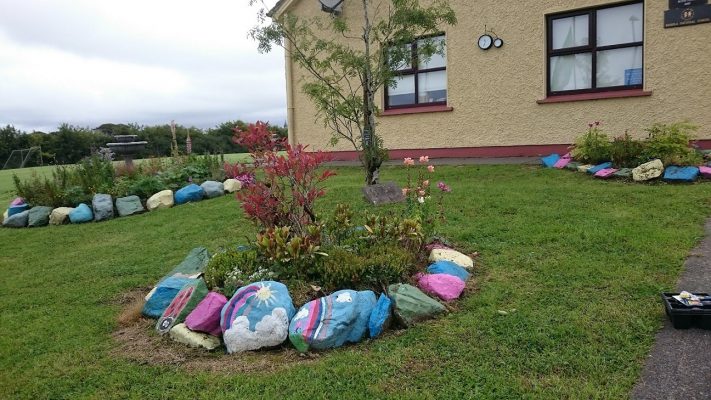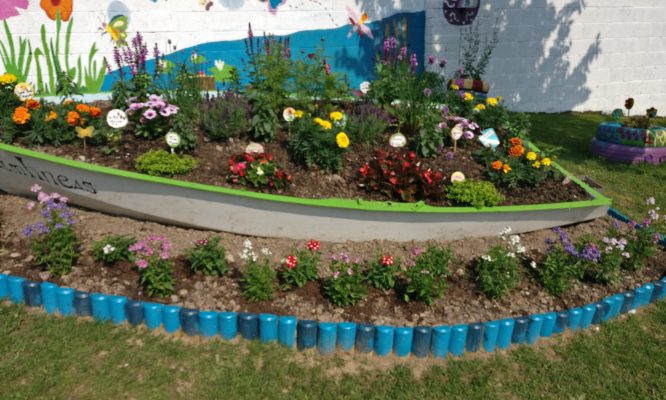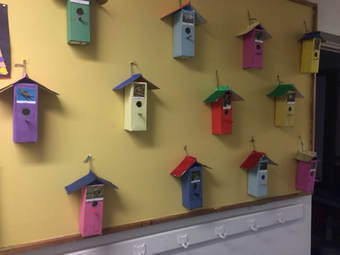
Category D – (Project run by a School – leading on biodiversity through education)
Scroll down the page to learn about the six projects shortlisted in this category

SCHOOL: St. Saviour’s National School, Station Rd, Rathdrum, Co Wicklow

Sept 2017 – Created a Team (parents, staff and children – student council & green schools committee) to reclaim an area of woodland on our school grounds.
Green Flag Participation
The positive biodiversity impact of the project
The project has positively impacted biodiversity in our school by increasing awareness of natural habitats present in our school through bug hotels, hedgehog homes, bat boxes and the importance of protecting our environment through composting, litter control. The children are completely involved in all aspects of the project through the Green School Committee and the Student Council. The senior children are partnered with the junior children to teach them about biodiversity in our school and work together to create a Greener biodiverse school.
The overall aim of the project is to increase awareness of the importance of biodiversity and for students and staff to come up with ways to help biodiversity. This was achieved through improving and preserving our local biodiversity through the measures introduced. Schools have a vital opportunity to play a role in promoting and preserving biodiversity both locally and globally which we have endeavoured to achieve.
SCHOOL: Bohola National School

Together with school pupils, teachers, Green Schools Committee, after-schools gardening club, Parents Association and local Brownies and Ladybird Irish Girl Guide units we have been developing a biodiversity sensory garden in the school. The work started three years ago thanks to grants from the Local Agenda 21 Environmental fund from Mayo County Council, with fruit trees, raised vegetable beds and bird boxes. This year we have been building on the biodiversity and sensory garden theme. We have planted three existing flower beds with pollinator friendly plants. One of the local men-sheds groups built us wooden planters which were painted bright colours and planted with herbs, grasses and pollinator friendly flowers. They also made us a bubby bench which then became two thanks to funds from the PA. We have most recently added a games picnic bench and story-time chair all built with recycled plastic. For the sensory garden we have also include a solar-power water fountain and large wind chime, and solar powered lights.
The positive biodiversity impact of the work
The children now have a much more colourful and biodiverse school grounds to play in. More bumblebees are seen visiting the flowers. While our vegetables were not as successful this year as last year, it is still a great way for the children to see where their food comes from. This year we only managed to grow one pumpkin for the school, while last year we had four, one for each classroom! In years to come we hope the children will be harvesting their own apples from the apple trees.
SCHOOL: Gaelscoil Charraig Uí Leighin

In Gaelscoil Charraig Uí leighin it was decided to work on a project that would support the National Pollinator Plan. We had a small commemorative garden and it was decided to extend this area to include a butterfly and bee garden. Our local scouting group gave us a boat and this set the tone for the garden, Lochán an tSonais. We wanted to use paint to create a bright and welcoming space so our next step was to paint our mural to depict a pond scene. Children and teachers worked together painting rushes, grasses, lilypads, dragonflies, bees, butterflies and ladybirds. In front of this wall we planted foxgloves, rushes and calendula plants that had been grown in the classroom using toilet rolls as pots. A member of Carrigaline Tidy towns visited to help create Mossaí the Mud head. This was made from mud, stones, moss, grass and succulents and the children loved it. Tyres were painted and planted with heather,salvia and buddleia, sourced from a number of locations around the town. The boat was named Suaimhneas and once the topsoil arrived we proceeded to plant it with herbs like thyme and chives. We also planted strawberries, lavender, cosmos, marigolds, begonias, calendula, anthirrinium and sage. We also added a bug hotel, a butterfly house and bird boxes to the garden. We created labels from small timber rings and a table and chairs from some old logs.
The positive biodiversity impact of the work
We aimed to encourage biodiversity by creating a wildlife-friendly habitat with wildflowers such as foxglove and buddleia and other plants which are bee-friendly such as lavender and chive. The children weren’t disappointed as many bees, butterflies were spotted during the Summer and into the Autumn. Other wildlife such as snails and woodlice were located. The wood piles, bug hotel and mud head also created habitats for various insect life.
SCHOOL: Urbleshanny National School

Our project was called the Sliabh Beagh Protectors. We focused on a number of issues affecting the Sliabh Beagh mountain special protected area (SPA) close to our school. We decided to concentrate on ‘Biodiversity Learning’ as a way to prevent illegal dumping and promote positive awareness of our beautiful Bragan Mountain, as us locals like to call it.
Up on Bragan mountain we have some amazing wildlife. Through our project we learned that the area is protected by European law under the Natura2000 network. We learned that a very important bird, the Hen Harrier lives on Bragan Mountain and that it’s numbers are dropping all across Ireland. We also learned about the other habitats and species in the area. Marsh fritillary butterfly, Hen harrier,Red grouse, Blanket Bog, Heath.
Our project was led by a panel of nine pupils from 5th and 6th They invited experts from the area to give talks, these included: Joe Shannon who works on the Curlew project, who talked about the birds, Dr. Rory Sheehan who worked for the CANN project talked about the blanket bog, Seán Clerkin from the National Federation of Group Water Schemes and Paddy Sherry a local wildlife enthusiast, with an extensive knowledge of the area. Nuala Madigan from the Irish Peatland Conservation Council presented a workshop to every class in the school.
Rory Sheehan took our panel out for a field trip on a very cold day to see the damage that turf cutting is doing to Bragan Mountain.
In the summer term, we arranged field trips to Sliabh Beagh, for every pupil in the school (307 children). Gretta McCarron from LAWCO and Jen Lynch from NPWS escorted 5th and 6th class and showed them how to assess the water quality of Sliabh Beagh’s streams and how to watch the ground nesting birds. 5th class visited the reservoir and water treatment facilities. Other classes had tours focused on identifying wildlife and habitats.
The positive biodiversity impact of the work
Illegal dumping and turf cutting are a big problem on Sliabh Beagh. Our brochure “Enjoy Sliabh Beagh” helped show our community some of the problems that biodiversity faces on the site. We obtained funding from Monaghan County Council to get 5000 copies printed and distributed within the local newspaper; The Northern Standard. We were also interviewed about the project by the news team in the local radio station, Northern Sound. This was very useful in informing people in the local area about the illegal dumping problem on Sliabh Beagh.
We held a poster competition in conjunction with the local Tidy Towns Committee based on this theme. These posters were displayed in the shops and businesses in Scotstown Village.
We organised for all school pupils to visit Sliabh Beagh and take a selfie of themselves up on Sliabh Beagh, for homework. This was a fantastic way to get parents and children reconnected with the mountain and even introduced a few of them to it, for the first time.
SCHOOL: Edmondstown National School

We set about learning more about Biodiversity and increasing awareness. We wanted to increase the Biodiversity in our school environment. We particularly wanted to create a bee corridor. We planted lots of heathers and lavenders in order to attract the bees. We installed a pond and created a sensory garden around it, choosing plants such as lemon balm, mint, thyme etc. for scent, grasses for sound, strawberries for taste, thistles and lamb’s ear for touch and colourful flowers for sight. We planted vegetables – potatoes, onions, peas. We planted a mini orchard with fruit bushes, apple trees and pear trees. We installed bug hotels, bird houses and a hedgehog house. We bought an Amuigh Faoin Spéir learning zone so that the children could sit outside and learn about biodiversity in situ. We put up beautiful pictures of wildlife in our school shelter so that the children could learn about our native wildlife whilst eating their lunches. We laminated pictures of native plants and animals from the Wildlife Trust and put them along the corridors.
During Geography class the children mapped habitat maps of the school ground and our Green School Committee helped plan how we could adapt our habitat to increase Biodiversity. During English classes, the children wrote poems about Biodiversity and during Music classes we even penned a song! The older children planted crocus whilst learning about the Holocaust in History. They also planted lots of spring bulbs. In Science the children learned about the different parts of plants and about the seasons. The older classes made graphs of the different species during their Maths classes. During S.P.H.E. the children became aware of their role in society to protect our environment and promote Biodiversity. Art classes were great fun as the children drew detailed sketches of different plants and the Junior and Senior Infants made colourful bugs on sticks to decorate the garden near their classroom. The children loved making bird houses from old milk cartons.
We got an expert from the Heritage council to give us a workshop on Bees. We asked the council to dredge the Owendoher river which borders our school as a lot of silt and debris had built up. Then we asked the Fisheries Board to give us a workshop and the children and teachers were overjoyed to find beautiful brown trout in our river.
The positive biodiversity impact of the work
The children in the school are now really aware of how important Biodiversity is to our world. Their awareness of their own impact on Biodiversity has increased. We have lots of wildlife now in our garden – squirrels, rabbits, bees, bugs, hedgehogs and even the odd deer comes down the mountain to pay us a visit! The Fisheries Board were delighted with the quality of the water in our river and they are determined to keep it that way. We were awarded our Green Flag for Biodiversity last May. We have also been chosen as a pilot school for a new Biodiversity flag – Global Citizenship, Biodiversity & Food Waste. Whilst we can’t quantify for sure if the number of bees has increased, we feel that it has and that this will continue as we add to our planting scheme.
SCHOOL: St. Colman’s Community College, Midleton, Co. Cork

St. Colman’s Community College students have undertaken the following:
The positive biodiversity impact of the work
This project is sponsored by Dublin Port Company